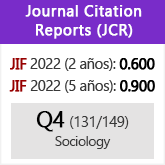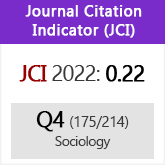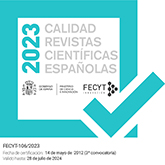Vuelco educativo y reducción de la homogamia: un análisis por cohortes de la formación de parejas en España
DOI:
https://doi.org/10.3989/ris.2023.81.2.21.01740Palabras clave:
Emparejamiento selectivo, España, Formación de hogares, Vuelco educativo femeninoResumen
El debate empírico y teórico sobre las implicaciones del vuelco educativo femenino en la formación de parejas sigue abierto. En este artículo, utilizando microdatos trimestrales de la EPA, se analizan los tipos de unión formados en España para las cohortes nacidas entre 1950-1988, un período lo suficientemente amplio como para captar las tendencias de largo recorrido. Para descontar la exposición diferencial al mercado matrimonial en un contexto como el español, donde la expansión formativa ha sido intensa, se aplican modelos loglineales. Los resultados muestran que la hipogamia es el tipo de unión que más crece. Esa evolución es asimétrica por parejas: llega antes y es mayor entre las mujeres más cualificadas, asociándose claramente a su incorporación al mercado laboral. Si se consideran las dificultades para superar determinados niveles y la influencia que ejerce el vuelco educativo femenino, la homogamia prevalece como forma de emparejamiento principal.
Descargas
Citas
Arpino, B., G. Esping-Andersen y L. Pessin. 2015. "How Do Changes in Gender Role Attitudes Towards Female Employment Influence Fertility? A Macro-Level Analysis". European Sociological Review 31(3): 370-382. https://doi.org/10.1093/esr/jcv002
Bell, D. 1976. El advenimiento de la sociedad postindustrial. Madrid: Alianza.
Benjamin Guzzo, K. 2006. "The relationship between life course events and union formation". Social Science Research 35(2): 384-408. https://doi.org/10.1016/j.ssresearch.2005.06.002
Bertrand, M., K. Emir. y J. Pan. 2015. "Gender identity and relative income within households". The Quarterly Journal of Economics, 130(2), 571-614. https://doi.org/10.1093/qje/qjv001
Blossfeld, H. y A. Timm. 2003. Who marries whom? Educational Systems as Marriage Markets in Modern Societies. Dordrecht: Kluwer Academic. https://doi.org/10.1007/978-94-007-1065-8
Blossfeld, H. 2009. "Educational assortative marriage in comparative perspective". Annual Review of Sociology 35: 513-530. https://doi.org/10.1146/annurev-soc-070308-115913
Breen, R. y L. Salazar. 2011. "Educational Assortative Mating and Earnings Inequality in the United States". American Journal of Sociology 117(3): 808-843. https://doi.org/10.1086/661778
Buss, D., T. Shackelford., L. Kirkpatrick y R. Larsen. 2001. "A Half Century of Mate Preferences: The Cultural Evolution of Values". Journal of Marriage and Family 63(2): 491-503. https://doi.org/10.1111/j.1741-3737.2001.00491.x
Carabaña, J. 1994. "La constante homogamia educativa". Economía y Sociedad, 11: 43-64.
Casterline, J. 2001. Diffusion Processes and Fertility Transition: Selective Perspectives. Washington: National Academy Press.
De Hauw, Y., A. Grow. y J. Van Bavel. 2017. "The Reversed Gender Gap in Education and Assortative Mating in Europe". European Journal of Population 33(4): 445-474. https://doi.org/10.1007/s10680-016-9407-z PMid:30976234 PMCid:PMC6241077
De la Fuente, A. y R. Doménech. 2018. "El nivel educativo de la población en España y sus regiones: actualización hasta 2016". BBVA Research. Documento de trabajo nº 18/04. Consulta en noviembre de 2021 (https://www.bbvaresearch.com/).
England, P. 2010. "The Gender Revolution: Uneven and Stalled". Gender and Society 24(2): 149-166. https://doi.org/10.1177/0891243210361475
Esping-Andersen, G., D. Boertien., J. Bonke y P. Gracia. 2013. "Couple Specialization in Multiple Equilibria". European Sociological Review 29(6): 1280-1294. https://doi.org/10.1093/esr/jct004
Esteve, A. y C. Cortina. 2006. "Changes in Educational Assortative Mating in Contemporary Spain". Demographic Research 14(17): 405-428. https://doi.org/10.4054/DemRes.2006.14.17
Esteve, A. y C. Cortina. 2010. "Expansión educativa e inmigración internacional en España: cambios en la formación de la pareja". Papers 95(3): 585-608. https://doi.org/10.5565/rev/papers/v95n3.46
Esteve, A., C. Schwartz., J. Van Bavel., I. Permanyer., M. Klesment y J. García-Román. 2016. "The End of Hypergamy: Global Trends and Implications". Population and Development Review 42(4): 615-625. https://doi.org/10.1111/padr.12012 PMid:28490820 PMCid:PMC5421994
Fernández-Lozano, I. 2019. "Fathers as Solo Caregivers in Spain: A Choice or a Need?". Journal of Family Issues 40(13): 1755-1785. https://doi.org/10.1177/0192513X19842214
Fernández, R., N. Guner y J. Knowles. 2005. "Love and Money: A Theoretical and Empirical Analysis of Household Sorting and Inequality". The Quarterly Journal of Economics 120(1): 273-344. https://doi.org/10.1162/qjec.2005.120.1.273
Fisman, R., S. Sheena., E. Kamenica y I. Simonson. 2006. "Gender Differences in Mate Selection: Evidence from a Speed Dating Experiment". Quarterly Journal of Economics 121: 673-697. https://doi.org/10.1162/qjec.2006.121.2.673
García Román, J. 2020. "The Division of Gender Roles in Female Breadwinner Couples in the US and Spain". Revista Española de Investigaciones Sociológicas 170: 73-94.
Garrido, L., M. Requena y L. Toharia. 2000. "La Encuesta de Población Activa desde la perspectiva de los hogares". Estadística Española 146(42): 115-152.
Garrido, L. 2005. "Elementos de contexto para el análisis". Pp.43-56 en Ocupación, formación y el futuro de la jubilación en España, coordinado por L. Garrido y E. Chuliá. Madrid: CES.
Gerson, K. 2010. The Unfinished Revolution: How a New Generation is Reshaping Family, Work, and Gender in America. Oxford: Oxford University Press.
González Lopez, M.J. (2003). Who Marries whom in Spain?. In: Blossfeld, HP., Timm, A. (eds) Who Marries Whom?. European Studies of Population, vol 12. Springer, Dordrecht. https://doi.org/10.1007/978-94-007-1065-8_7
González, M., I. Lapuerta., T. Martín-García y M. Seiz. 2018. "Satisfaction with Work-Life Balance: Couples with Egalitarian Practices in their Transition to First-Time Parenthood in Spain". L'Année sociologique 68(2): 341-366. https://doi.org/10.3917/anso.182.0341
Grow, A. y J. Van Bavel. 2015. "Assortative Mating and the Reversal of Gender Inequality in Education in Europe: An Agent-Based Model". PLoS ONE 10(6): 1-24. https://doi.org/10.1371/journal.pone.0127806 PMid:26039151 PMCid:PMC4454664
Grow, A. y J. Van Bavel. 2018. "Agent-Based Modeling of Family Formation and Dissolution". Pp. 125-156 en Analytical Family Demography, editado por R. Schoen. Cham: Springer. https://doi.org/10.1007/978-3-319-93227-9_6
Gutiérrez-Domènech, M. 2010. "Parental employment and time with children in Spain". Review of Economics of the Household 8(3): 371-391. https://doi.org/10.1007/s11150-010-9096-z
Ibáñez, M. 2017. Mujeres en mundos de hombres. La segregación ocupacional a través del estudio de casos. Madrid: CIS.
Kalmijn, M. 1994. "Assortative Mating by Cultural and Economic Occupational Status". American Journal of Sociology 100(2): 422-452. https://doi.org/10.1086/230542
Kalmijn, M. 1998. "Intermarriage and homogamy: Causes, patterns, trends". Annual Review of Sociology 24: 395-421. https://doi.org/10.1146/annurev.soc.24.1.395 PMid:12321971
Kanji, S. 2013. "Do fathers work fewer paid hours when their female partner is the main or an equal earner?". Work, Employment and Society 27(2): 326-342. https://doi.org/10.1177/0950017012460321
Klesment, M. y J. Van Vabel. 2017. "The Reversal of the Gender Gap in Education, Motherhood, and Women as Main Earners in Europe". European Sociological Review 33(3): 465-481.
Lichter, D. y Z. Qian. 2018. "The Study of Assortative Mating: Theory and Analysis". Pp. 303-337 en Analytical Family Demography, editado por R. Schoen. Cham: Springer. https://doi.org/10.1007/978-3-319-93227-9_13
Mare, R. 2016. "Educational Homogamy in Two Gilded Ages: Evidence from Intergenerational Social Mobility Data". The Annals of the American Academy of Political and Social Science, 663: 117-139. https://doi.org/10.1177/0002716215596967
Martínez Pastor, J. 2006. "La homogamia educativa de las nuevas mujeres en España". Revista Internacional de Sociología 64(43): 69-94.
Martín-García, T., M. Seiz y T. Castro-Martín. 2017. "Women's and Men's Education and Partnership Formation: Does the Field of Education Matter?". European Sociological Review 33(3): 393-409. https://doi.org/10.1093/esr/jcx047
Mayoral, D. y L. Samper. 2006. "Cambio social y homogamia educativa." Revista Internacional de Sociología 64(43): 35-67.
Miret, P. 2010. "La similitud entre los componentes de las parejas jóvenes en España en la primera década del siglo XXI ¿Cada vez más iguales?". Revista de Estudios de Juventud 90: 225-255.
Neyt, B., S. Vandelbulcke y S. Baert. 2019. "Are men intimidated by highly educated women? Undercover on Tinder". Economics of Education Review 73,101914. https://doi.org/10.1016/j.econedurev.2019.101914
Qian, Y. 2017. "Gender Asymmetry in Educational and Income Assortative Marriage". Journal of Marriage and Family 79(2): 318-336. https://doi.org/10.1111/jomf.12372
Qian, Z. y D. Lichter. 2018. "Marriage markets and intermarriage: Exchange in first marriages and remarriages". Demography, 55, 849-875. https://doi.org/10.1007/s13524-018-0671-x PMid:29693225
Sayer, L. 2005. "Gender, Time, and Inequality: Trends in Women's and Men's Paid Work, Unpaid Work and Free Time". Social Forces 84: 285-303. https://doi.org/10.1353/sof.2005.0126
Schwartz, C. y R. Mare. 2005. "Trends in educational assortative marriage from 1940 to 2003". Demography 42: 621-646. https://doi.org/10.1353/dem.2005.0036 PMid:16463914
Schwartz, C. 2010. "Earnings Inequality and the Changing Association Between Spouses' Earnings". American Journal of Sociology 115: 1524-1557. https://doi.org/10.1086/651373 PMid:20657705 PMCid:PMC2908420
Schwartz, C. 2013. "Trends and variation in assortative mating: Causes and consequences". Annual Review of Sociology 39: 1-20. https://doi.org/10.1146/annurev-soc-071312-145544. https://doi.org/10.1146/annurev-soc-071312-145544
Schwartz, C. y H. Han. 2014. "The Reversal of the Gender Gap in Education and Trends in Marital Dissolution". American Sociological Review 79(4): 605-629. https://doi.org/10.1177/0003122414539682 PMid:25364012 PMCid:PMC4212646
Schwartz, C., Z. Zhen y Y. Xie. 2016. "Marrying Up by Marrying Down: Status Exchange between Social Origin and Education in the United States". Sociological Science 3: 1003-1027. https://doi.org/10.15195/v3.a44 PMid:28066795 PMCid:PMC5214284
Seiz, M., M. González., T. Jurado., I. Lapuerta y T. Martín-García. 2019. "Non-normative Couples in Spain: Mothers'Career Commitment, Fathers'Work Arrangements and Egalitarian Ideology". Pp. 169-186 en New Parents in Europe. Work-Care Practices & Family Polices, editado por D. Grunow y M. Evertsson. Cheltenham: Edward Elgar. https://doi.org/10.4337/9781788972970.00019 PMCid:PMC6663001
Smits, J., W. Ultee y J. Lammers. 1998. "Educational homogamy in 65 countries: an explanation of differences in openness using country-level explanatory variables". American Sociological Review 63: 264-285. https://doi.org/10.2307/2657327
Van Bavel, J. 2012. "The reversal of gender inequality in education, union formation, and fertility in Europe". Vienna Yearbook of Population Research 10: 127-154. https://doi.org/10.1553/populationyearbook2012s127
Van Bavel, J., C. Schwartz y A. Esteve. 2018. "The Reversal of the Gender Gap in Education and Its Consequences for Family Life". Annual Review of Sociology 44: 341-360. https://doi.org/10.1146/annurev-soc-073117-041215
Zentner, M. y A. Eagly. 2015. "A sociocultural framework for understanding partner preferences of women and men: Integration of concepts and evidence". European Review of Social Psychology 26(1): 328-373. https://doi.org/10.1080/10463283.2015.1111599
Publicado
Cómo citar
Número
Sección
Licencia
Derechos de autor 2023 Consejo Superior de Investigaciones Científicas (CSIC)

Esta obra está bajo una licencia internacional Creative Commons Atribución 4.0.
© CSIC. Los originales publicados en las ediciones impresa y electrónica de esta Revista son propiedad del Consejo Superior de Investigaciones Científicas, siendo necesario citar la procedencia en cualquier reproducción parcial o total.Salvo indicación contraria, todos los contenidos de la edición electrónica se distribuyen bajo una licencia de uso y distribución “Creative Commons Reconocimiento 4.0 Internacional ” (CC BY 4.0). Puede consultar desde aquí la versión informativa y el texto legal de la licencia. Esta circunstancia ha de hacerse constar expresamente de esta forma cuando sea necesario.
No se autoriza el depósito en repositorios, páginas web personales o similares de cualquier otra versión distinta a la publicada por el editor.
Datos de los fondos
Gobierno del Principado de Asturias
Números de la subvención BP-16146

















